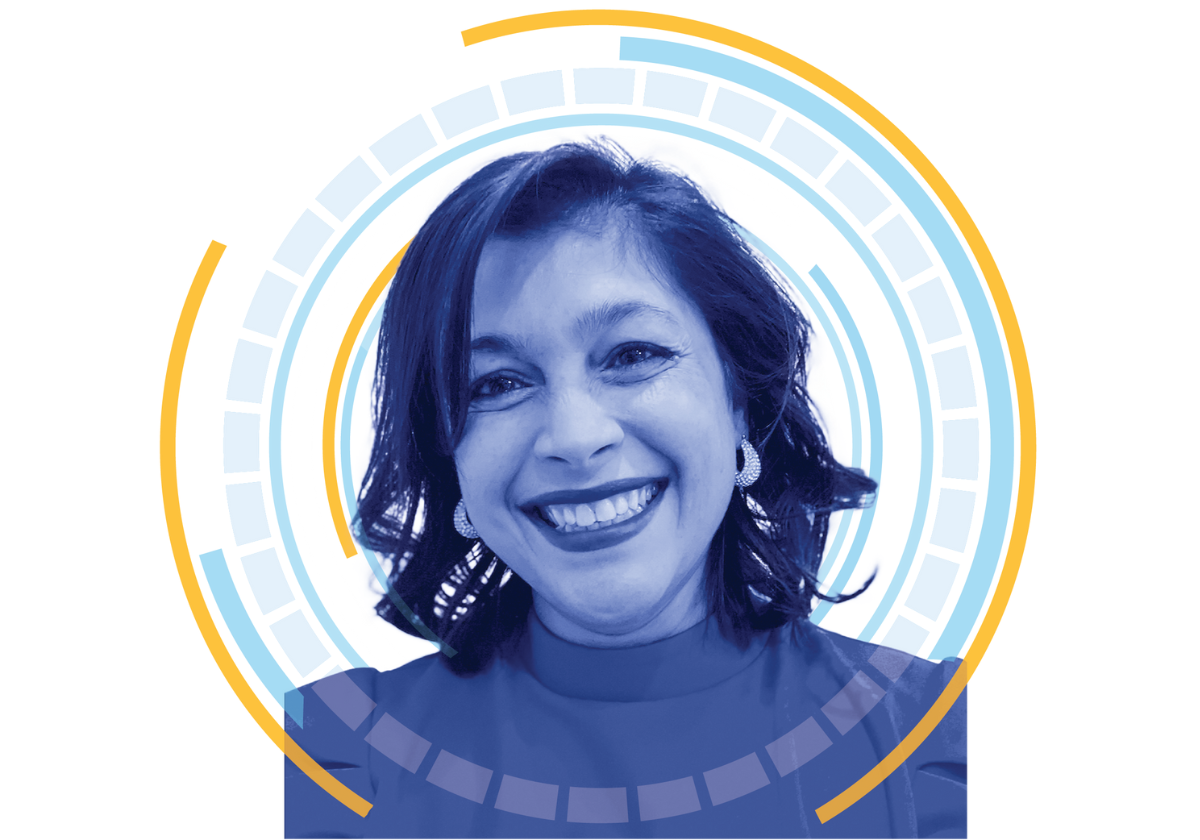Dipu Patel is a physician assistant (PA) by training and an educator by choice. But her real passion lies in innovation.
As professor and vice chair of Innovation in the Department of PA Studies, she is passionate about ensuring that future practitioners have the most effective tools at hand to ensure patients receive the best possible care and achieve the best possible outcomes.
In today’s health care environment, that includes the constantly evolving digital health tools.
“Over the past decade we have all become familiar with electronic health records, telemedicine, wearable technologies and health apps,” notes Patel. “AI, specifically GenAI, falls under the same umbrella and is quickly shifting how we care for patients.”
GenAI—generative artificial intelligence (AI)—learns patterns from existing data, such as evidence-based medicine, and uses this knowledge to generate new outputs or predictions.
The Nation’s First and Only Digital Health Course
Patel is not a bystander in this digital landscape. She has developed the country’s first and only digital health course for students in the school’s Doctor of Medical Science (DMSc) program.
According to Patel, the goal of the Fundamentals of Digital Health course is to help students gain an understanding of the benefits and challenges of various digital health technologies and their impact on patient care and clinical practice. Topic areas include definitions, benefits and challenges, as well as future trends and their potential impact on future practice.
Patel hopes that with this foundation, students will be able to assess and adopt new tools as they evolve in the future.
“I like that this course teaches adaptability to a new skill set,” says Patel. “But it also helps the health care provider overcome the fear of AI taking over their job. It validates the point that GenAI plus human expertise equals better care.”


An Evolution in the Practice of Patient Care
Patel gives the example of how GenAI might improve a typical patient visit. Instead of the provider typing away at a computer while the patient talks about symptoms or concerns, artificial intelligence can document the conversation while the provider gives the patient their full, undivided attention. Patel says this will allow the provider to pick up on certain cues or behaviors that may have gone unnoticed while they were busy typing notes.
Furthermore, the AI-documented information would become part of the patient’s electronic health record and could be used in the future to help physicians identify potential genetic or larger population diseases.
“When you look at it this way, you can see AI is not a change in the quality of care, rather an evolution in the practice of it,” she continues.
In October 2024, Patel received an SHRS Innovation in Education Award to help SHRS faculty and students become more comfortable with using artificial intelligence tools. “This may be the only course on campus that encourages students to use large language models to engage with AI and analyze its use,” says Patel. “It’s about lowering the threshold to engage with AI tools and taking away the fear.”
Interprofessional Conversations on AI

She recently launched another new initiative, “Discovering Innovative Possibilities of the Use of AI” through weekly digital office hours. Every Wednesday, experts from several schools and colleges meet virtually to dive into AI-related topics, share insights and collaborate on innovative ideas.
Patel says this space has been especially valuable because faculty from business, computer sciences and humanities are joining those from the health care professions in these conversations.
“The most important skills for the future will be adaptability and flexible thinking paired with curiosity,” says Patel. “This applies both to the teacher and the learner in all disciplines.”
Writing the Book on Digital Health
Patel has also published a new book, “Digital Health: Telemedicine and Beyond,” that uses case studies and patient outcomes to provide an overview of digital medicine, terms, concepts and applications for the multidisciplinary clinical practitioner.
It addresses the ethical and social challenges that digital health raises, how to engage patients to improve shared decision-making models and how digital health tools can be integrated into clinical practice.
“Keeping the human in the loop is crucial to how we use any form of digital health, especially AI,” notes Patel. “It can make us more efficient and better at what we do because it arms us with so much information. But it’s important to note that AI is not making medical decisions—health care professionals are making those decisions.”
Patel’s expertise and leadership has an impact on a national level. In January 2025, she was elected president of the Physician Assistant Education Association (PAEA), where she hopes to broaden the knowledge of the benefits of artificial intelligence among practicing physician assistants.
“We are nowhere near the peak of where AI can take us,” predicts Patel. “But we are at an inflection point of the partnership between humans and AI.”
Digital Health Course Outcomes
One student’s perspective on Patel’s Fundamentals of Digital Health course includes Jeff Midgley (DMSc ’24), PA program director and clinical associate professor, Marist College, who says he entered the course “as a geek who loves medicine and technology and left as someone with a vast toolkit to tackle complex challenges.”
“Our main task for the course was to design a telehealth service for a hypothetical rural community,” explains Midgley. “This was not just simply a process of getting patients access to a computer and clinicians access to a telemedicine system. It was about learning how to create infrastructure which has many applications in industry, health care, administration and academics. It was learning about those things through the use of different AI programs, and how to appraise the work that we did using AI.”
In addition to learning foundational concepts, Midgley appreciated the AI feedback reflections that were completed after submitting assignments.
“They provided a lot of thoughtful reflection on how we utilized the tools to build our health care system as well as the limitations and biases that came with using those tools,” notes Midgley. “I developed a solid enough foundation that I am now comfortable sharing these tools with others.”
He has made several medically related technology presentations and was named co-chair of the academic portion of his college’s AI steering committee. In this role, he will be paving the way for the increased use of AI at his own institution.
Midgley says the tools he learned about in class are already informing his work. “We learned in an environment where we were able to explore AI tools and apply them to relevant medical settings to create meaningful projects that will prepare us to care for the patient of the future. I’m passing this information on to my students.”


